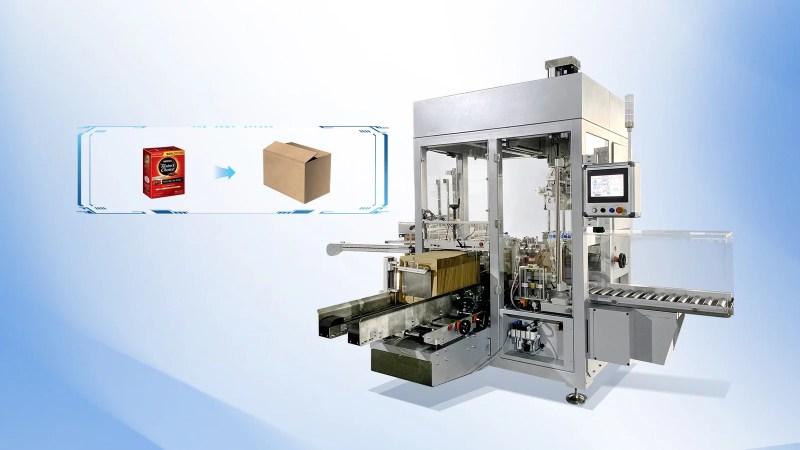Choosing the right case packing machine can be confusing—especially when you’re comparing top-load and side-load case packers.
The main difference between top-load and side-load case packers lies in their loading direction—vertical vs. horizontal—which affects speed, product compatibility, and layout.
If you’re in the market for secondary packaging machines, this guide will help you understand which case packer fits your production line and product type better.

How do top-load case packers work?
Not all products can handle being pushed sideways—some need a more delicate touch. That’s where top-load case packersw.douglaspackaging.com/advantages-of-a-top-load-case-packer/) case packers come in.
Top-load case packers load products vertically from above, making them ideal for fragile items like bottles or stand-up pouches.
Why top-load is the go-to automatic case packer for fragile goods
From my experience working with packaging lines for cosmetics, food, and health products, top-load case packers often solve product-damage issues. These machines use robotic arms or gantry systems to place items gently into the case from above. This vertical loading minimizes the impact on sensitive packaging materials.
Key Features of Top-Load Case Packers
| Feature | Description |
|---|---|
| Loading Direction | Vertical (top to bottom) |
| Ideal For | Fragile items, pouches, jars, bottles |
| Speed | Moderate, very precise |
| Space Use | Taller footprint, smaller floor space |
| Popular Use Cases | Case packer for bottles, stand-up bags, trays |
If you’re using automatic case packers in industries where packaging integrity is essential, like pharmaceuticals or glass containers, top-load machines may give you fewer issues long term.
How do side-load case packers work?
When speed matters and your product can handle a push, side-load case packers shine.
Side-load case packers push products horizontally into the case, making them perfect for fast-moving lines packing cartons or boxes.
Why side-load case packers dominate high-output lines
Side-loaders are straightforward. A case is positioned, and a mechanical arm pushes products sideways into the case. This design is often used in beverage or canned food production. It’s a good fit when the product is consistent in size and shape.
Key Features of Side-Load Case Packer
| Feature | Description |
|---|---|
| Loading Direction | Horizontal (side to side) |
| Ideal For | Rigid products like cartons, canned goods, boxed items |
| Speed | High, perfect for fast-paced lines |
| Space Use | Requires more horizontal floor space |
| Suitable Product Types | Food trays, multipack cartons, shrink-wrapped units |
If you’re evaluating different types of case packers, side-load designs offer high speed and simpler mechanical motion. However, they may struggle with oddly shaped or fragile products.
Which case packer is easier to maintain?
Maintenance issues cost time and money. So, which machine type causes fewer interruptions?
Top-load packers offer better access for cleaning, while side-loaders usually have simpler mechanisms with fewer moving parts.
What matters more—cleaning or complexity?
If you’re dealing with spill-prone items like powders or oils, you’ll appreciate how top-load case packing machines are designed. Their open top allows better visibility and access for cleanup. But for dry environments, side-load case packers tend to require less frequent servicing due to their linear motion.
Maintenance Comparison Table
| Factor | Top-Load Case Packer | Side-Load Case Packer |
|---|---|---|
| Cleanability | High | Medium |
| Moving Parts | More (robotics, arms) | Fewer (linear mechanisms) |
| Breakdown Frequency | Low with sensitive products | Low with rigid products |
| Downtime Cost | Higher for complex systems | Lower due to simplicity |
No matter your choice, I recommend working with a supplier like Hannpro, which offers easy access to spare parts and modular designs for both styles.
Which case packer saves more floor space?
Factory layout can be tight. How much room do you actually need for each packer?
Top-load case packers use vertical space more efficiently, while side-load case packers take up more room lengthwise.
Vertical vs Horizontal: the real layout tradeoff
A top-load case packer usually stands taller but stays compact on the ground. That makes it ideal for operations where floor space is limited but you have ceiling height. On the other hand, side-load case packers need more horizontal clearance but can fit under lower ceilings.
Factory Space Needs
| Metric | Top-Load Case Packer | Side-Load Case Packer |
|---|---|---|
| Vertical Clearance | Higher | Lower |
| Horizontal Footprint | Compact | Extended |
| Space Efficiency | Ideal for stacked layout | Ideal for continuous straight lines |
For one client, we fit a top-load automatic case packer under their mezzanine filler. It saved them almost 20% in usable floor area.
Which case packer handles more product types?
Many lines aren’t just packing one item. Flexibility matters—so who wins here?
Top-load case packers handle more product variations, while side-load packers work best with uniform SKUs.
SKU changeovers and flexibility needs
With top-load systems, robotic arms or pick-and-place heads can adapt to different shapes and sizes. This is ideal for operations with multiple packaging formats. Side-loaders are best for large batches of similar products, such as canned drinks or boxed food.
Flexibility in Product Handling
| Criteria | Top-Load Case Packer | Side-Load Case Packer |
|---|---|---|
| SKU Variety | High | Moderate |
| Changeover Speed | Fast (with automation) | Slower (manual adjustments) |
| Jam Resistance | Better for irregular shapes | Best for rigid formats |
If your line packs a mix of SKUs, I usually steer clients toward top-load case packers—they adapt better and need fewer adjustments between runs.
Conclusión
The difference between top-load and side-load case packers comes down to your specific needs: fragility, speed, space, and SKU flexibility all matter. Choose the right one, and your packing line runs smoother.
